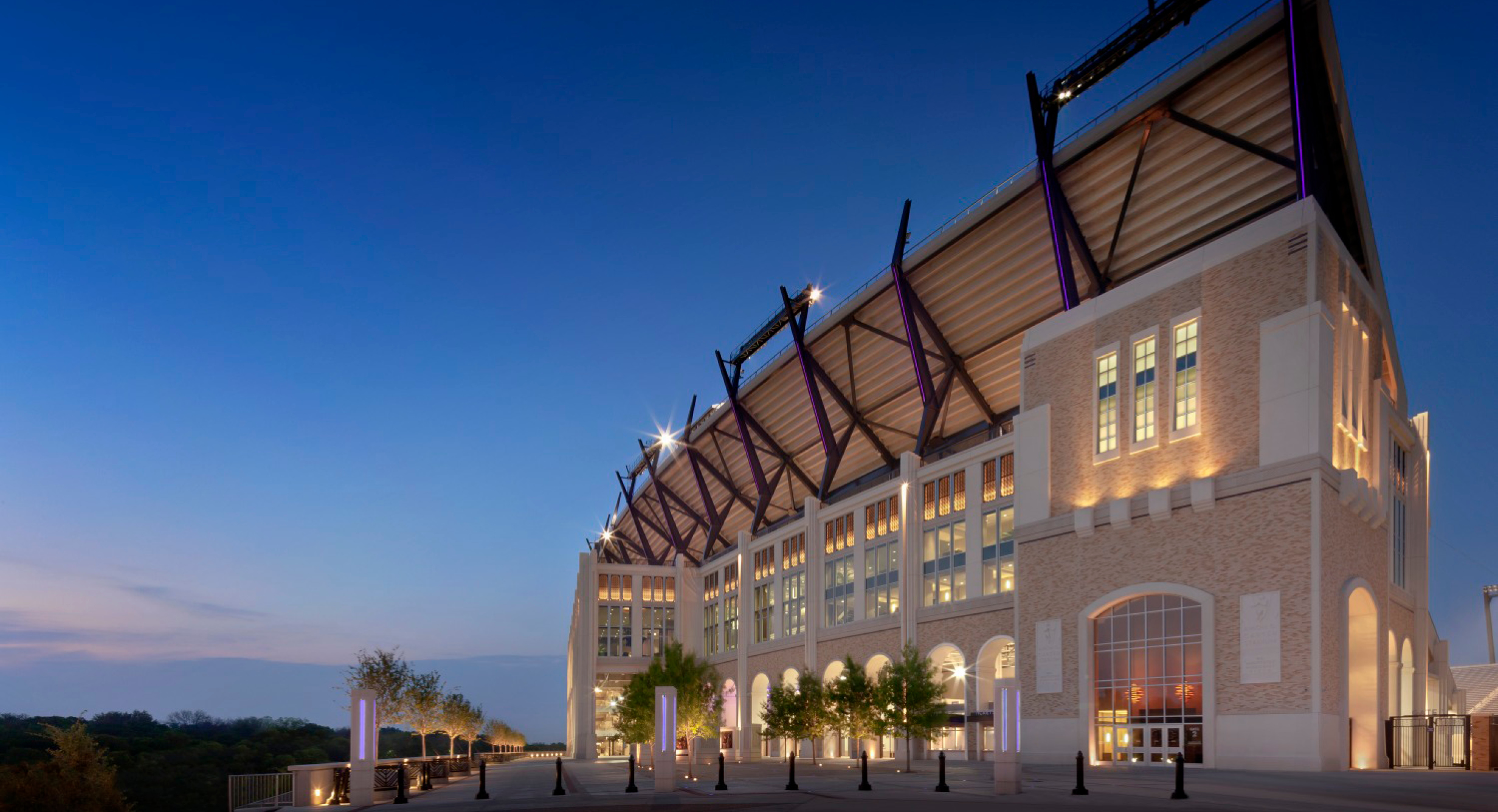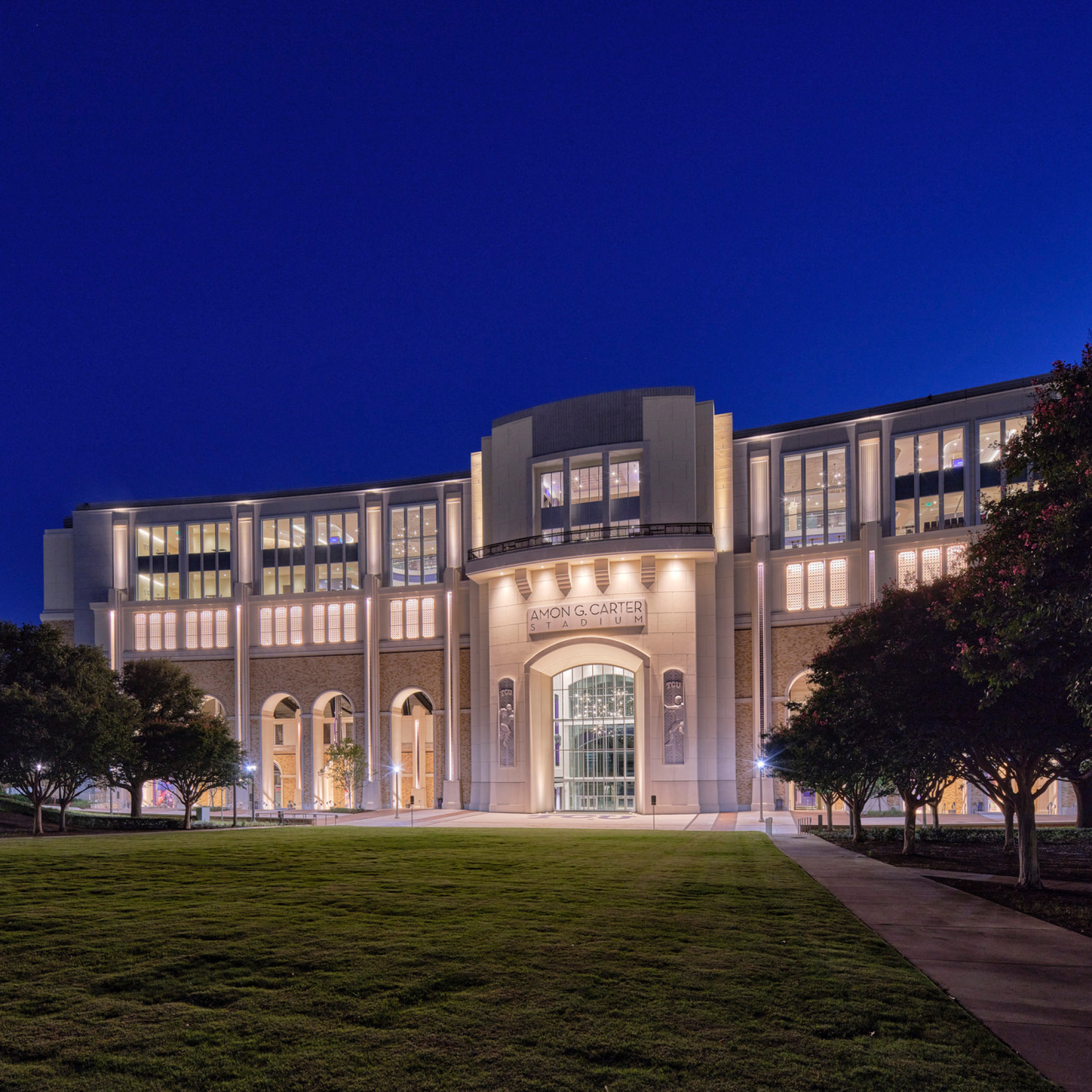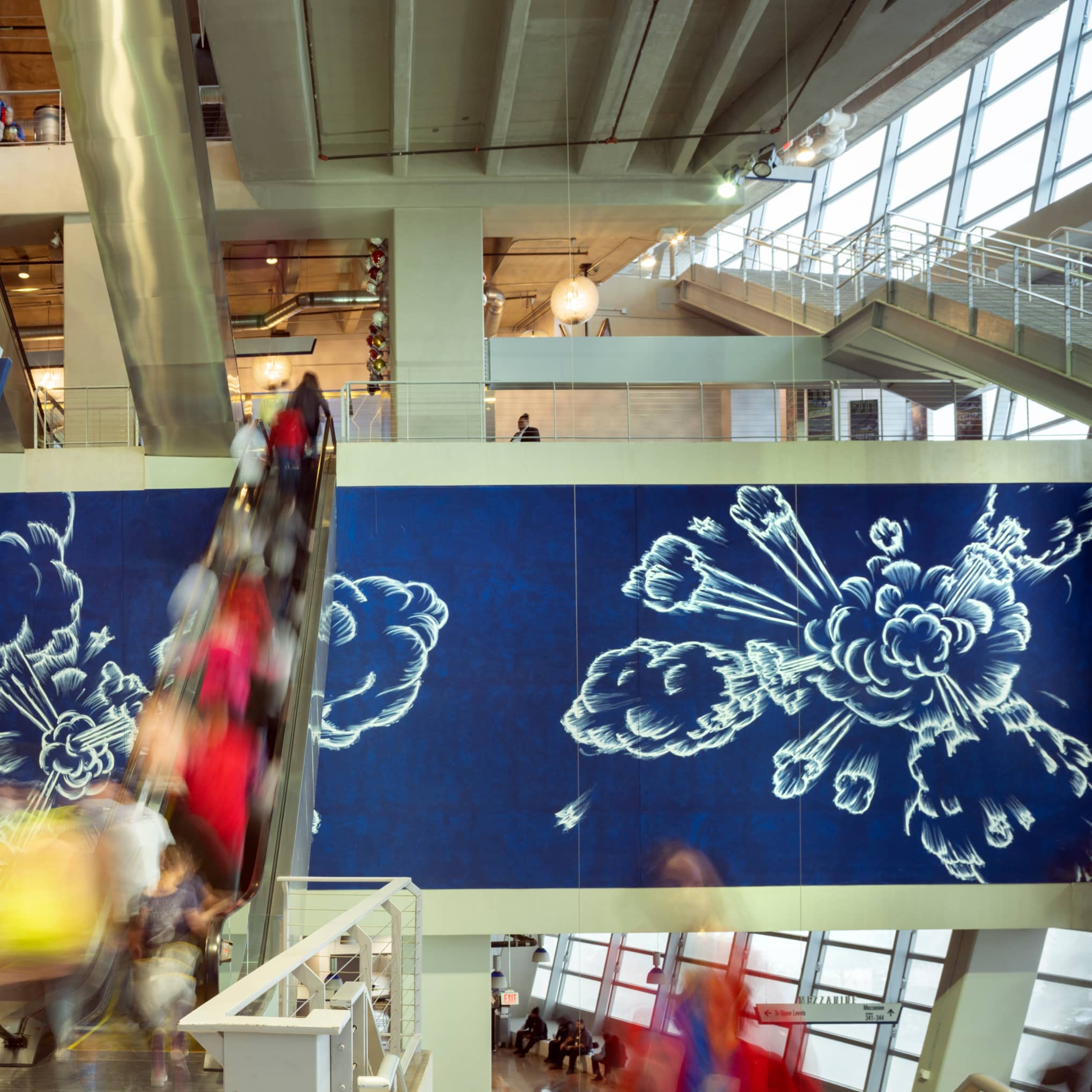
How First-Class Collegiate Sports Facilities Fuel Winning Teams
During his 44-year career at Texas Christian University (TCU), T. Ross Bailey oversaw $650 million in construction of athletic facilities at the Fort Worth university. Those shiny new structures, Bailey said, have helped propel the Horned Frogs’ recent on-field success, including this year with the school’s first trip to the College Football Playoffs.
“As we saw facilities grow, we’ve seen athletics grow, whether it be conference football championships, Bowl games, or four straight trips to the College World Series,” said Bailey, retired Senior Associate Director of Athletics at TCU. “That growth of success on the fields, on the courts, in the arena, goes right along with the growth of athletic facilities.”
For college athletics leaders such as Bailey, who still works with TCU Athletics as a consultant, there is little doubt in their minds that first-class facilities translate into victories and championships. They help boost recruiting, practice and game performance, and attracting financial contributions from alumni and other supporters.
HKS has a long history of working with colleges and universities across the country to design and develop top-notch stadiums, arenas, natatoriums and other athletic facilities. In addition to the firm’s partnership with Bailey and TCU, it has ongoing projects at the Universities of Mississippi, Georgia, Western Kentucky, the Air Force Academy and several others.
“Spaces help define us,” said Meggie Meidlinger, an HKS Project Architect. “For collegiate athletes, if you are in a space centered around excellence – excellence of training, excellence of performance, excellence in education, excellence in team camaraderie and support for your school, then that just pushes you out of the gate and onto the field for better player performance.”
Meidlinger, a pitcher on the USA Women’s National Baseball Team, is one of several current and former athletes at HKS who design athletic facilities. She noted that one key to athletic success is to practice like you play. “How you perform on the field is a grand summary of all the little things you do throughout your day to train and practice for the main event,” she said.
Rise to Prominence
Back at TCU, the television broadcast of the team’s last home game of the seasonat the school’s 50,000-seat Amon G. Carter Stadium reached a reported 4.34 million viewers. Recent updates at the historic stadium are the result of a nearly 15-year, multiphase project by the university and HKS to revitalize TCU’s practice and game environments.
“It’s been a really wonderful project, because it coincided with TCU football’s rise to real prominence,” said David Skaggs, HKS Architect and Principal.
Originally a member of the now-defunct Southwest Conference, TCU was invited to join the Big 12 Conference in 2012. “Facilities development was part of why the Big 12 was interested in TCU,” said Bailey. Not only were the university’s sports programs investing in new facilities, “they were filling them,” he said.
But long before those stadium or arena seats are filled with adoring fans, the athletes, coaches, and staff must put in hours of planning, preparation and perseverance. HKS designers are a big part of those pre-game, out-of-the-spotlight processes as well.
Fred Ortiz, Global Practice Director of HKS’ Sports & Entertainment practice and a Principal at the firm, said well-designed facilities help athletes to better prepare, perform and recover.
“There’s a flow to that,” said Ortiz, a former football player at the University of Texas at Arlington. Properly laying out spaces for activities like nourishment, weight training and hydrotherapy “creates those touchpoints that allow the student-athletes and the coaching staff to work in a very efficient and effective way,” he said.
Efficiency is incredibly important for collegiate athletic programs, said Mike Drye, Director of HKS’ Richmond, Virginia, office and a Principal at the firm. The NCAA limits student-athletes’ daily and weekly participation in what the association terms “countable athletically related activities” (CARA), so an athlete’s every minute is valuable.
Drye noted that one advantage of indoor facilities is that they allow teams to avoid weather delays during practices. Virginia Tech Beamer-Lawson Indoor Practice Facility, designed by HKS, and Virginia Military Institute Indoor Training Facility, designed by HKS in association with Richmond-based Commonwealth Architects, are two such examples.
“You see a lightning strike, you don’t have to go into your locker room and wait for it to pass. You just move practice into the indoor facility and keep practicing, so you lose five minutes, not 20,” Drye said.

Supporting the Whole Athlete
In addition, the more time that streamlined facility designs can give back to a player, the more a sports program is “enhancing the whole person: mind, body, spirit,” said Ortiz.
HKS embarked on a research project in 2021 to learn more about leveraging the built environment to enhance athletic performance, recovery and well-being. An interdisciplinary team including experts from HKS’ Sports & Entertainment and Health practices, and the firm’s Advisory Services group, identified five characteristics of facilities designed support the whole athlete. Such facilities are:
- Integrated – so technologies, specialists and facilities can unite, communicate and work as a team to care for the athlete
- Holistic – to nurture the athlete’s mind, body and spirit
- Optimized – providing access to the right staff and the right care at the right time to optimize performance
- Personalized – to allow solutions for enhancing human performance (diet, training, rehab, etc.) to be tailored to each athlete, injury or sport
- Adaptable – to meet the needs of personalized performance plans and ever-changing technology
College “athletes are on all the time,” said Drye, a member of the research team. “They finish practice and they run back to class. Having spaces that prioritize the entire health and well-being of athletes…is really important.”
This approach to facility design can include details as fine as installing circadian lighting, which mimics the progression of sunlight throughout the day. Circadian lighting is designed to help regulate individuals’ sleep/wake cycles, so they rest better at night and are more alert during the day – an especially useful feature when players return to a facility late at night from an away game or meet.
Spaces for studying, tutoring, socializing or receiving mental health care “speak to the well-being of athletes on many levels,” Skaggs said. “Athletic departments realize they need to provide these kinds of environments to attract the top-flight student-athletes to their programs.”
Energy and Excitement
Collegiate sports facilities can also impact athletic performance by delivering an extraordinary experience for alumni and other fans.
“When you have a stadium that’s jam packed and it’s loud, that just hypes you up more for your playing experience,” said Meidlinger.
“You want to play for any crowd with energy and excitement,” added Michelle Stevenson, HKS Senior Project Architect and Principal. Stevenson is a former Rice University soccer player who is part of the HKS effort to design a new women’s soccer stadium at the University of Mississippi.

She noted that there are several details involved in designing spaces for an elevated fan experience, including lighting, acoustics, restrooms, food service (including local favorites), site lines that work for a variety of events, patron flow and life safety measures.
“These are table stakes,” when it comes to designing collegiate sports facilities, Stevenson said, adding that those facilities must also be “steeped in the tradition of the school.”
This requires an understanding on the part of the design team of, for example, the traditional location of the student section or pep band. Seating can then be designed to ensure that other fans’ views aren’t obstructed by tubas or students who stand and cheer throughout the game.
Designing Beyond Gameday
Well-designed facilities also tailor the game-day experience for different types of fans.
“It’s not all seats,” says Meidlinger. For example, she said that HKS’ latest baseball stadium designs include areas for fans down the left field line, standing room only areas near the home and visitors’ bullpens, and priority seating.
“You’re bringing in everyone who wants to see a game – not just one group of people, but those who want to sit and watch every inning, those who want to talk and hang out and those who want to be loud and annoy the visiting team,” said Meidlinger, who is part of the design team working on a new baseball stadium for the University of Georgia.
And exceptional fan experiences reverberate beyond gameday.
“Stadiums today stand for something, have a personality and become iconic designs for players and fans,” said Meena Krenek, HKS’s Global Practice Director of Venues Interiors and a Principal at the firm. “We are always expressing a team’s brand and emotion in unique ways, so fans can find greater connection to the team and their values,” she said.
“Stadiums today stand for something, have a personality and become iconic designs for players and fans.”
Collegiate athletic facilities enhance a community by serving as venues for collective experiences, both for the campus and the local community around it. Bailey noted that as TCU sports programs rose in prominence, the school’s enrollment also increased.
“And I’ll tell you, man, all of that helps Fort Worth grow,” Bailey said, adding that with Amon G. Carter Stadium, the goal was “not just to build another football stadium. Our goal was to build a destination spot for our fans and alumni.”


